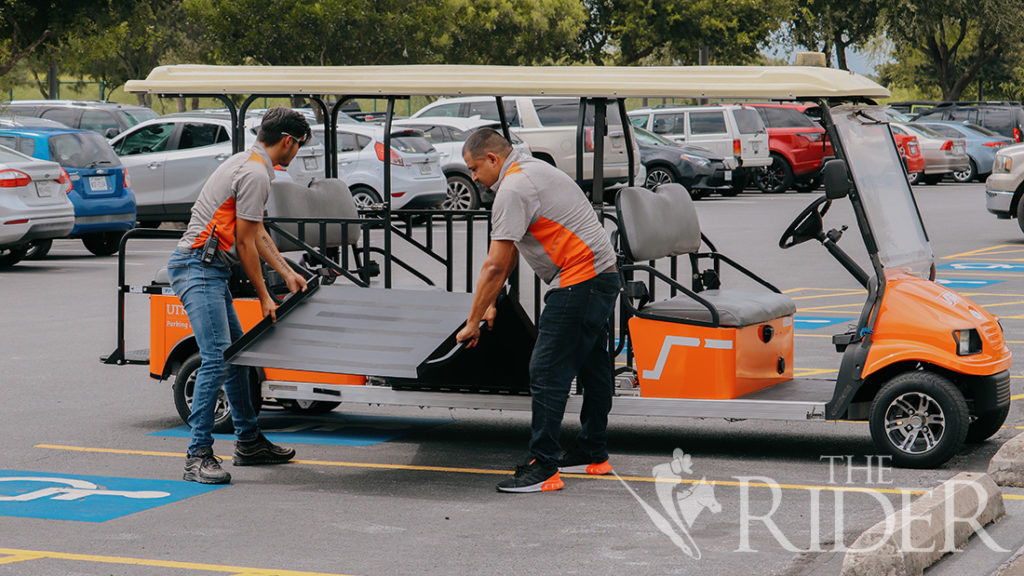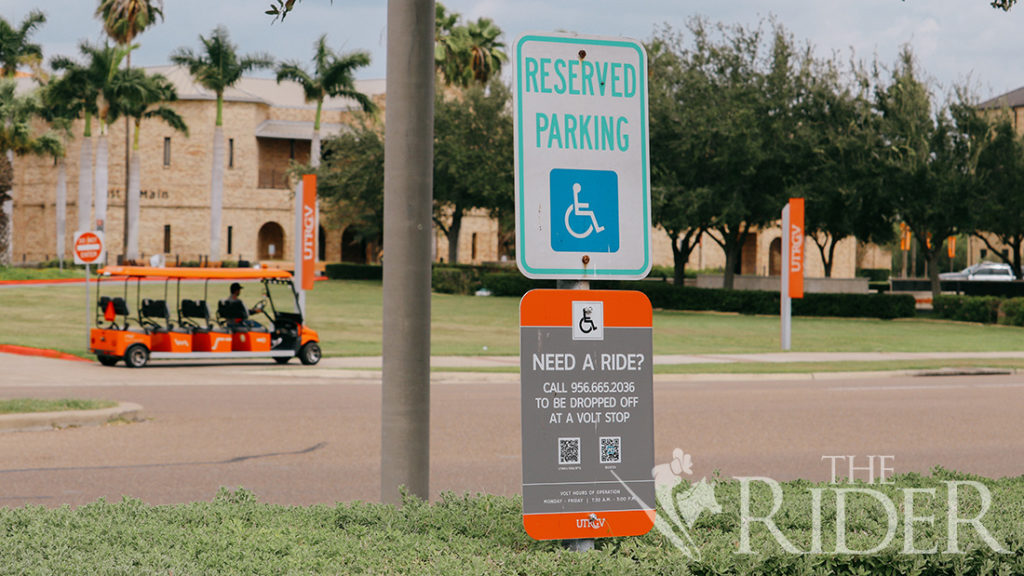
Driver Nick Ramirez (left) and Transportation Supervisor Jose Ibarra unfold the ramp on the VOLT installed to provide access for students with disabilities on the Brownsville campus. Luis Martinez Santillano/The Rider Photos
As of Aug. 23, the university’s micro mobility program, VOLT, is now providing Call Stop services to individuals who have disabilities.
Students with disabilities can call in to request a pickup, according to Ian Chavez, UTRGV’s assistant director of Transportation.
The Call Stop service is being provided to the Brownsville campus specifically because of heavy traffic at the university driveway, Chavez said.
“Anybody who can park there legally, right, in the ADA spot, can request a ride from there,” he said. “We pick you up from that point right there, and we take you to one of our designated stops.”
The designated stops are located along the pink and yellow VOLT circuits in Brownsville and can be found online at utrgv.edu/volt.
“It is going to be treated kind of like a call stop,” Chavez said. “A call stop, basically, [is not on] one of our frequent routes, [but] our passengers can request a pickup.
Information about the service is now posted by Accessible Parking spots on the Brownsville campus.

Luis Martinez Santillano/The Rider Photos
“I want to say [it took] maybe about a month and a half in total to get the official signs,” Chavez said. “We had to go through different drafts and [work out] how to put this on there.”
The signs, which will be posted alongside Americans with Disabilities Act (ADA) signage, provide hours of operation and QR codes to the VOLT routes and website. The service phone number, 665-2036, is also listed.
Any calls for a pickup will be dispatched to an available VOLT driver, Chavez said. To request a pickup, individuals only need to provide their vehicle’s location, make, model and color to help the driver locate them.
This semester, there has already been one user for the service, he said.
“They weren’t in a wheelchair, but [not everyone] with a disability [has] to have that,” Chavez said. “It could be an invisible disability. … She was very grateful when we dropped her off at the designated stop.”
He said the service is still a rather novel thing.
“We want to just try our best with the available resources we have right now,” Chavez said. “We’re not even at full 100% for the semester yet, and you already see the traffic going back and forth. We want to do our best to help out any way we [can] in addressing the congestion.”
The service was created after a student raised a concern regarding accessibility on the Brownsville campus.
“I saw people struggling to get back and forth to class,” said Charles Dayton, a political science senior. “… I thought I was alone in this, like maybe I’m just the only one that’s having issues with this stuff, right? But I wasn’t, and I didn’t realize that until that Rider story.
“I was shocked by some of the comments considering it was 2020. I didn’t think, like, this kind of stuff still happened, this day in age, right? So, I was really surprised.”
Dayton is referring to a Feb. 3, 2020, story headlined “Accessibility Issues,” in which disabled students on campus spoke about the struggles they face. The story motivated him to alert the school to the issues through Vaqueros Report It.
“I’ve brought three issues to the university and all three took months, if not a year or more, to actually figure a solution out,” Dayton said. “And to me, that’s like the opposite of what Vaqueros Report It is supposed to be, right? It’s supposed to be an efficient, effective service for students to report things that they see issues with.”
It was not until measurements were taken to reveal how far disabled students had to travel that the requests started gaining attention, he said. The measurements were taken on campus using a compact measuring wheel he bought at Home Depot.
“Well, I would go to, like, Walmart and Home Depot and Target, and I would see, like, their disability parking was right by the door,” Dayton said. “I went actually to these places and measured myself. It normally was like between 50 and 100 feet to get in from parking to the door.”
It took around three or four hours to take all the measurements on campus, he said. The results showed distances on campus to be roughly four or five times longer in comparison than other public locations.
“I knew without those measurements no one would realize exactly how far people were walking because if you’re not disabled and you don’t have any problem with mobility, it’s no big deal, really,” he said. “I mean, it is a walk, don’t get me wrong. But, like, it doesn’t seem to be as big a deal.
Dayton said that having the measurements is what really shed light on the issue.
“I will give [Dean of Students Rebecca] Gadson credit, because I just don’t think she knew,” he said. “Because I think as soon as she saw the presentation and the measurements and everything, she was like, ‘Oh, you know, we have a problem here,’ and then things started happening very quickly after she got on board.”
Dayton, who is a disabled combat veteran himself, said that while he does not experience mobility issues, he has seen other veterans with prosthetics and in wheelchairs who struggle to travel on campus.
“Well, it gives me hope that the system, you know, finally something happened,” Dayton said. “I don’t want to put out a story out that destroys that. I don’t want students to turn sour on the situation. I want things to continue to get better and progress for the disabled community.”
Dayton said he is happy that the dean of students and Transportation has finally done something to address the issue, but he is disappointed in how long it took for the information to get to them.
“There’s something in that process that isn’t quite right,” he said. “I have been talking about this for years.”
Chavez said a large-scale plan to address the situation is ideal, but that the university wanted to do something to address the issue in the meantime.
“What that large-scale plan is, I don’t exactly know,” Chavez said. “But I know it’s going to go beyond VOLT, hopefully, one day, to kind of address [these issues].”
VOLT will continue to offer the Call Stop service on the Brownsville campus alone, for now.
“Since it was conducted because of the primary concern of the university driveway, I don’t think Edinburg is one of our main targets right now,” Chavez said. “It hasn’t been brought up.”
The steps to implement services such as this one are different on each campus.
“In Brownsville, we are not 100% funded through [the] Federal Transit Administration,” Chavez said. “There’s more steps involved in Edinburg because of our funding structure.”
Because of this, any solutions pitched to Edinburg would need to be presented in a public forum where people can collaboratively come up with a solution.
“I guess I kind of want to see more of the feedback from passengers, or anyone that may request it,” Chavez added. “We’re going to try to learn from Brownsville to see what opportunities can arise from here, but nothing yet for Edinburg.”





